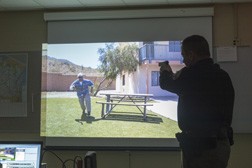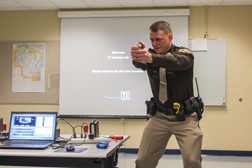I Shot With the Sherriff
- Share
- Tweet
- Pin
- Share
Two deputies and Sheriff Steve Delarwelle stand in a dark room as the projector on the wall counts down from three. The screen fades in and a man is sitting at a picnic table outside of an apartment complex playing with a kitchen knife by stabbing it into the wooden table. Deputy Scott Walker steps forward and asks the man what he is doing.

Door County Sheriff Steven G. Delarwelle explains how the shooting simulator works. Photos by Len Villano.
“Just leave me alone!” the man yells back as he stands up. “You guys are always around me, you always bug me. Listen, I don’t want any more of your crap!” He lunges toward Walker with the knife raised. Walker draws a red gun prop and fires at the screen. The man drops and Delarwelle turns on the lights.
“It’s the decision making,” said Chief Deputy Pat McCarty about the value of the software. “To be able to go through it frame by frame and discuss what decision they made and when they made it.”
The program is a Use of Force Training Simulator provided to the department for two weeks from Northeast Wisconsin Technical College (NWTC). The Public Safety program at the college rents the equipment to the department for $200, which they share with the Sturgeon Bay Police Department.
“It’s a tough time of year for us to go out and shoot at the range so that’s why the simulator is really good to utilize in the winter,” said McCarty.
The sheriff’s department set up a range at a gravel pit in Union that is owned by the county. Yet between inclement weather, travel time and ammunition costs, the department was limited in how often they could use the range.
“From a training perspective it’s a lot cheaper to come in here when we’re both working as opposed to me going out to the range on overtime where our training costs go up and it’s also cheaper to fire at a simulator as opposed to firing boxes and boxes of ammunition,” said McCarty.

The simulator can set up targets and track where an officer shoots the prop gun on the screen, providing marksman practice without wasting live rounds.
Yet the department sees the true benefit of the software in the scenarios that are recorded and reproduced.
Scenarios range from traffic stops and court sentencing to domestic calls and bar fights. When the pre-recorded scene begins, an officer does not know how it is going to end. Each scene has a variety of endings that the administrator can choose from. The same subject may be compliant or pull a gun on the officer depending on which branch the administrator chooses. An officer in training won’t know until they must make a decision.
“With these branching scenarios I can have multiple officers come in here running through the same scenario and give them different outcomes,” said McCarty.
In a simulation, Walker approached an intoxicated man behind a dumpster. In one case, the man reached into his pocket and pulled out a cell phone. In another, he drew a gun and fired on the officer.
As the weather warms, the department will take these scenarios outside and face live subjects with paint rounds to better simulate a true encounter.
The simulations count toward a state-mandated 24 hours of annual training for each deputy. The Door County Sheriff’s Department consistently exceeds this minimum standard, clocking an average of 6,298 hours of training annually. Training goes toward a variety of certifications such as Defense and Arrest Tactics and Principles of Subject Control.
Luckily, the department has not needed to apply this lethal force training in their outside work. Delarwelle cannot recall a single instance in which deadly force by the department killed someone.
“I think part of you can say it is luck,” said McCarty, “But I think we have well-trained officers that are able to control situations through their verbalization skills.”
Verbalization skills are an important part of an officer’s training and the scenarios in simulation software allow officers to train that skill as well.

Door County Sheriff Chief Deputy Patrick J. McCarty explains the proper use of force, when and when not to pull your weapon, during shooting situation simulator training.
“We don’t want to set our officers up for failure by running them through scenarios that every time they’re going to utilize force,” said McCarty. “A majority of the time we are able to de-escalate things with our verbalization skills.”
In order to use deadly force, there are three things that a deputy must consider. Weapon, intent and delivery make up the Attack Theory.
All three elements of the Attack Theory must be in place for an officer to use deadly force.
“If you think about it, every fall, the third week of November, we’ve got guys with weapons and most of them have the ability to use their weapons. But they don’t have the intent,” said McCarty. “If I have an elderly subject with a knife but he is confined to a wheelchair, he has a weapon, he has the intent to use it… he just doesn’t have the delivery system.”
Along with Attack Theory, the threat must be imminent and the officer must eliminate all other options such as withdrawing or finding cover. An officer on duty is charged with weighing each of these measures in the time it takes a person to pull something out of their pocket.
The department invited the Peninsula Pulse and other county media outlets to try the simulator themselves. As untrained citizens grappled with the prop gun, facing campers with broken glass bottles for weapons and a convict threatening to kill himself in the court room, it was clear that public safety is best reserved for those with the skills and training provided by the department.

